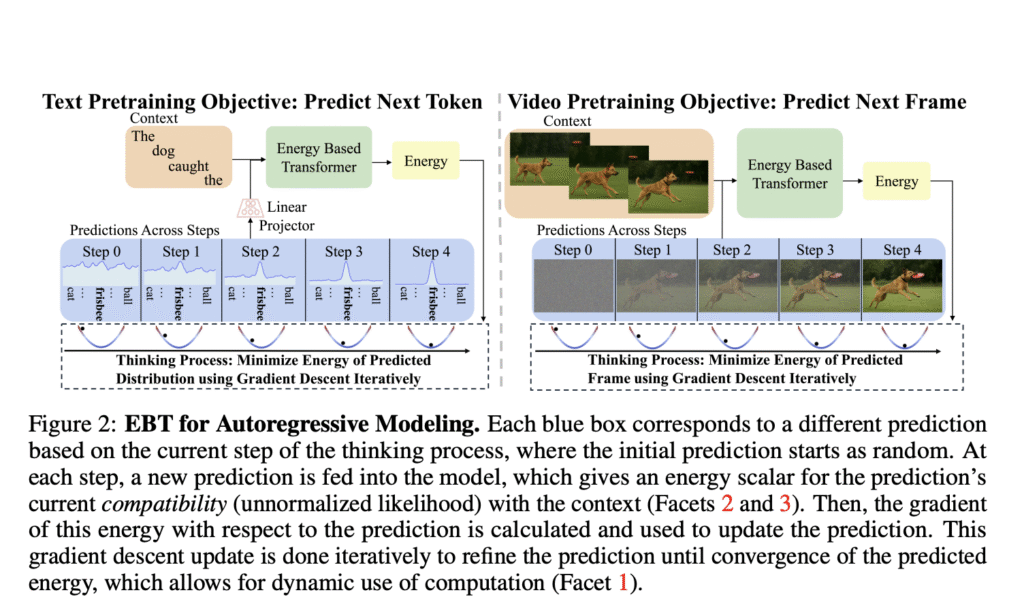Artificial intelligence research is rapidly evolving beyond pattern recognition and toward systems capable of complex, human-like reasoning. The latest breakthrough in this pursuit comes from the introduction of Energy-Based Transformers (EBTs)—a family of neural architectures specifically designed to enable “System 2 Thinking” in machines without relying on domain-specific supervision or restrictive training signals.
From Pattern Matching to Deliberate Reasoning
Human cognition is often described in terms of two systems: System 1 (fast, intuitive, automatic) and System 2 (slow, analytical, effortful). While today’s mainstream AI models excel at System 1 thinking—rapidly making predictions based on experience—most fall short on the deliberate, multi-step reasoning required for challenging or out-of-distribution tasks. Current efforts, such as reinforcement learning with verifiable rewards, are largely confined to domains where correctness is easy to check, like math or code, and struggle to generalize beyond them.
Energy-Based Transformers: A Foundation for Unsupervised System 2 Thinking
The key innovation of EBTs lies in their architectural design and training procedure. Instead of directly producing outputs in a single forward pass, EBTs learn an energy function that assigns a scalar value to each input-prediction pair, representing their compatibility or “unnormalized probability.” Reasoning, in turn, becomes an optimization process: starting from a random initial guess, the model iteratively refines its prediction through energy minimization—akin to how humans explore and check solutions before committing.
This approach allows EBTs to exhibit three critical faculties for advanced reasoning, lacking in most current models:
- Dynamic Allocation of Computation: EBTs can devote more computational effort—more “thinking steps”—to harder problems or uncertain predictions as needed, instead of treating all tasks or tokens equally.
- Modeling Uncertainty Naturally: By tracking energy levels throughout the thinking process, EBTs can model their confidence (or lack thereof), particularly in complex, continuous domains like vision, where traditional models struggle.
- Explicit Verification: Each proposed prediction is accompanied by an energy score indicating how well it matches the context, enabling the model to self-verify and prefer answers it “knows” are plausible.
Advantages Over Existing Approaches
Unlike reinforcement learning or externally supervised verification, EBTs do not require hand-crafted rewards or extra supervision; their system 2 capabilities emerge directly from unsupervised learning objectives. Moreover, EBTs are inherently modality-agnostic—they scale across both discrete domains (like text and language) and continuous ones (such as images or video), a feat beyond the reach of most specialized architectures.
Experimental evidence shows that EBTs not only improve downstream performance on language and vision tasks when allowed to “think longer,” but also scale more efficiently during training—in terms of data, compute, and model size—compared to state-of-the-art Transformer baselines. Notably, their ability to generalize improves as the task becomes more challenging or out-of-distribution, echoing findings in cognitive science about human reasoning under uncertainty.
A Platform for Scalable Thinking and Generalization
The Energy-Based Transformer paradigm signals a pathway toward more powerful and flexible AI systems, capable of adapting their reasoning depth to the demands of the problem. As data becomes a bottleneck for further scaling, EBTs’ efficiency and robust generalization can open doors to advances in modeling, planning, and decision-making across a wide array of domains.
While current limitations remain—such as increased computational cost during training and challenges with highly multi-modal data distribution—future research is poised to build on the foundation laid by EBTs. Potential directions include combining EBTs with other neural paradigms, developing more efficient optimization strategies, and extending their application to new multimodal and sequential reasoning tasks.
Summary
Energy-Based Transformers represent a significant step towards machines that can “think” more like humans—not simply reacting reflexively, but pausing to analyze, verify, and adapt their reasoning for open-ended, complex problems across any modality.
Check out the Paper and GitHub Page. All credit for this research goes to the researchers of this project.
Meet the AI Dev Newsletter read by 40k+ Devs and Researchers from NVIDIA, OpenAI, DeepMind, Meta, Microsoft, JP Morgan Chase, Amgen, Aflac, Wells Fargo and 100s more [SUBSCRIBE NOW]
Nikhil is an intern consultant at Marktechpost. He is pursuing an integrated dual degree in Materials at the Indian Institute of Technology, Kharagpur. Nikhil is an AI/ML enthusiast who is always researching applications in fields like biomaterials and biomedical science. With a strong background in Material Science, he is exploring new advancements and creating opportunities to contribute.


